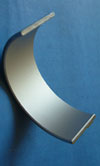Tri-metal Journal bearings: materials and construction
 Traditional journal bearings for internal combustion are of the tri-metal type. This type of bearing consists of a steel backing, a hard middle layer and a soft top layer. Typical soft bearing materials are: lead, tin, zinc, or alloys of these metals while typical hard bearing materials are: Aluminium-tin; lead-bronze; copper-lead. The soft top could comprise of three layers, providing five metal layers.
Traditional journal bearings for internal combustion are of the tri-metal type. This type of bearing consists of a steel backing, a hard middle layer and a soft top layer. Typical soft bearing materials are: lead, tin, zinc, or alloys of these metals while typical hard bearing materials are: Aluminium-tin; lead-bronze; copper-lead. The soft top could comprise of three layers, providing five metal layers.
Journal bearings operate between the extremes of no lubrication on the one hand, to thick-film lubrication on the other. Therefore, bearing material must possess compressive strength in order to withstand the loading due to the gas pressure and also fatigue strength to withstand the cyclic loading of the rotating journal. It must however be soft enough to allow foreign particles to be embedded and yet resistance to wear, resistance to corrosion and a low coefficient of friction are also important considerations.
All bearing materials have a pressure-velocity operating envelope, within which they function safely. The maximum pressure that the bearing can accept is determined by the hardness of the surface while the maximum velocity (of the journal within the bearing) is determined by heating within the bearing. This heating may be due to friction heating caused by metal-to-metal contact, as well as due to shearing of the oil film. The velocity is therefore restricted by the thermal conductivity of the bearing material.
Crankshaft journals are case hardened to the extent where they can abrade the foreign particles. The bearing surfaces are kept soft as this allows the foreign particles to become embedded in the soft bearing material and reduces the probability of wear elsewhere in the engine. The soft material should have a low modulus of elasticity, to enable it to deform within its elastic limit and therefore to absorb the hard particles. This property of the bearing material to absorb hard materials, is known as embeddability. Another property of the soft bearing material is known as conformability which allows for slight misalignments of the journal and the soft bearing material.
Due to the mechanical properties of the soft bearing material, it should be squeezed out due to the forces acting upon it. However, to prevent the soft bearing material from being squeezed out, it is made thin and is then supported by a much harder material. The rationale behind the thin layer of soft material is as follows: Consider a thick layer of plasticine between two blocks of wood under pressure – this leads to the plasticine being easily deformed and squeezed out of the sides. As the plasticine gets thinner, more pressure is required to cause it to flow laterally, and subsequently more pressure is required to deform it. The thin layer of plasticine that remains between the blocks cannot be squeezed out altogether. That would require an infinite pressure.
This effect of not being able to squeeze out all of the soft material is known as the principle of plastic constraint. It is used in bearing design and enables a very thin layer of soft metal to be deposited onto the hard bearing material. This layer is thick enough to embed dirt particles yet thin enough to support the journal forces without being squeezed out.
The soft bearing material acts like a lubricant when there is little or no lubrication, and due to its low melting point, it may also melt locally to prevent seizures occurring. If the layer of soft metal did not exist, frictional heating due to metal-to-metal contact would lead to a much higher bearing temperature. This would lead to gross atomic bonding between the journal asperities and bearing asperities followed by seizure. All things being equal, this would lead to bearing damage with little or no damage to the crankshaft journal.
Because the thin overlay of bearing metal can be worn away before the end of the normal operating life of the bearing, it is normal to have a second thicker, harder layer of bearing material beneath the soft thin layer which is bonded to a steel backing strip. In the event of loss of the soft, thin layer, the harder layer can still protect the journal.
If the roughness of the sliding surfaces is reduced, the load carrying capacity of the bearing is increased. Hence the requirement for a very good quality finish of the bearing surfaces is an important means of increasing load capacity, reliability and service life. Surface treatments can be used to improve the quality of the journal surfaces.
Written by Eric Smart.